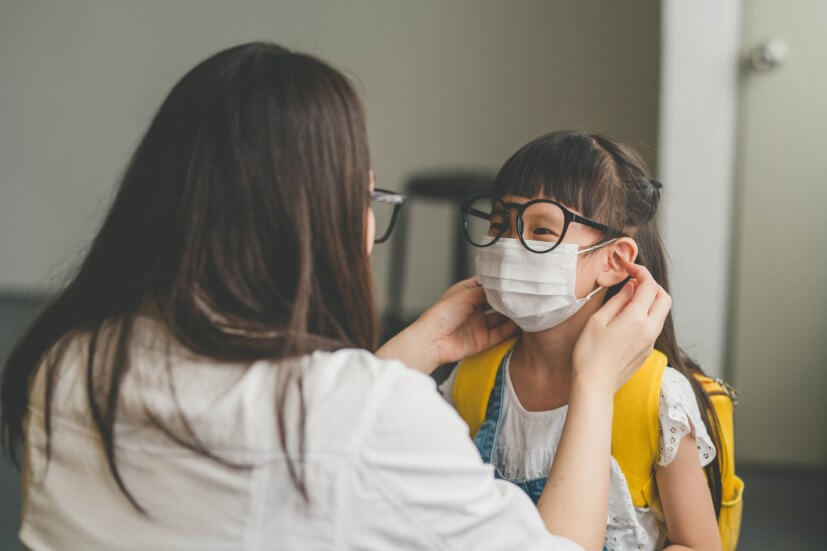Common Childhood Injuries & Illnesses and How to Prevent Them
Navigating the journey of parenthood brings its share of challenges and joys, particularly in safeguarding the childhood experiences of your children. In a world brimming with exploration and learning, everyday adventures like a playful day in the rain or energetic classroom activities bring both delight and potential safety concerns.
While it's impossible to protect your child from every minor injury or illness, there are numerous effective ways to create a safer environment at home and equip your child to navigate the world with confidence. Here, we’ll delve into the common types of injuries and illnesses that children encounter and offer preventive measures to make the world a more approachable place for your young ones.
Common Childhood Injuries
The childhood years, characterised by curiosity and a zeal for exploration, often lead to inevitable bumps and scrapes. While these are a normal part of growing up, their significance shouldn't be underestimated. At KK Women's and Children's Hospital, for instance, of the nearly 400 children visiting the Children's Emergency daily, approximately 1 in 10 are treated for injuries resulting from childhood accidents.
Drowning is also a critical concern, as recent data indicates that from 2012 to 2023, 49% of child injury deaths in children aged 16 and below were due to drowning. This alarming fact underscores the urgent need for heightened safety measures, especially around water sources. It emphasises the importance of every parent understanding these common injuries and knowing how to respond swiftly and effectively. In this section, we explore the most frequent childhood injuries, including drowning, their causes, typical scenarios, and first aid responses.
1. Skin Abrasions
Causes and Common Scenarios: These are caused by falls or scrapes during active play, such as running or climbing. They are most common on exposed skin like knees, elbows, and hands.
First Aid Tips: Gently clean the wound with mild soap and water to remove dirt and debris. After drying, apply an antibiotic ointment to prevent infection and cover with a sterile bandage. Keep the wound clean and dry, and change the dressing regularly.
2. Fractures and Sprains
Causes and Common Scenarios: Fractures or sprains often occur during physical activities like sports or playground play. They can result from falls, sudden impacts, or awkward landings.
First Aid Tips: Immobilise the affected area immediately. Use an ice pack or a cold compress to reduce swelling and pain. For severe cases, especially if a fracture is suspected, seek medical attention promptly. Avoid applying direct heat or pressure to the injured area.
3. Bruises
Causes and Common Scenarios: Bruises are usually the result of minor impacts or bumps, often occurring in active play environments. They can appear on any body part but are more visible on the legs and arms.
First Aid Tips: Apply a cold compress or an ice pack wrapped in a cloth to the bruised area for 15 to 20 minutes. Repeat several times a day to reduce swelling and discomfort. Elevating the bruised area can also help.
4. Choking
Causes and Common Scenarios: Young children exploring with their mouths can lead to swallowing or inserting foreign objects like beads or food pieces. These incidents most commonly occur at home, where small items are within reach.
First Aid Tips: If the child is choking, follow choking first aid guidelines immediately. For non-emergency situations, prevent access to small objects and educate children about the dangers of placing foreign objects in their mouth, nose, or ears. If an object is swallowed or inserted, seek medical advice.
5. Drowning
Causes and Common Scenarios: Drowning risks peak in young children, particularly around unsupervised water bodies like bathtubs and pools. Limited swimming skills and unawareness of water dangers, especially in children under 5, contribute to this risk.
First Aid Tips: In drowning cases, immediate removal from water and CPR, if necessary, are critical. Always seek medical attention post-incident. Prevent drowning by constant supervision, teaching water safety and swimming skills early, and securing areas around water sources like pools with safety barriers. Remove toys from pools to avoid temptation for children.
Parental Vigilance and Preparedness
Understanding these common injuries and knowing how to administer first aid can significantly mitigate their impact. Equally important is the role of parents in proactively creating a safe environment for their children. Fortunately, with advancements in child safety, childproofing tools have become more readily available and effective. Key measures include securing heavy furniture, using hinge protectors to prevent fingers from getting caught in doors, installing cushioned edge guards on sharp angles, and placing child safety locks on medicine cupboards, drawers containing hazardous tools, and access to areas around water.
Despite these precautions, accidents can still occur. In such instances, having the right insurance cover, such as Income’s PA Secure, can provide invaluable peace of mind. This plan offers coverage of up to $2,000 for medical expenses for injuries due to an accident, alleviating financial concerns during unforeseen events and allowing you to focus all your attention on your child's recovery and well-being.
Common Childhood Illnesses
Childhood, a critical time for physical growth and exploration, is also when children are susceptible to certain illnesses. Two common health concerns are food poisoning and infectious diseases, requiring vigilant attention from parents.
1. Food Poisoning
Children's innate curiosity and developing immune systems often make them more susceptible to food poisoning. The Centers for Disease Control and Prevention note that young children are at a higher risk due to their less mature immune systems, which are still learning to combat bacteria and viruses effectively.
Prevention Strategies: Teaching children about good hand hygiene and proper food handling is vital in preventing food poisoning. Encourage them to wash their hands with soap and water before eating, avoid consuming food that has fallen on the floor, and learn to recognise the signs of food spoilage, such as unusual smells or appearances.
Recognising and Managing Symptoms: Common symptoms of food poisoning include nausea and vomiting. When these occur, providing prompt care is important. This includes ensuring the child stays hydrated and gets sufficient rest. If symptoms persist or worsen, seeking medical attention for appropriate treatment and guidance is advisable.
2. Infectious Diseases
In environments like infant care and child care centres, close contact and shared spaces significantly increase the risk of children contracting infectious diseases. As explained by Dr Ng Chung Wai, Family Physician and Chairperson (Infection Control & Infectious Diseases Workgroup) at SingHealth Polyclinics, "Going to school and childcare exposes a child to large numbers of other children, which, in turn, increases the likelihood of exposure to germs."
In these settings, young children, with their developing immune systems, are particularly vulnerable to illnesses such as Hand, Foot and Mouth Disease (HFMD), known for its blister-like sores; Dengue Fever, characterised by high fever and rash; and respiratory illnesses like Mumps, Rubella, and Measles. Zika virus and Chicken Pox are also common, presenting with unique symptoms like skin rashes and fluid-filled blisters.
While childcare centres contribute significantly to children's social and intellectual development, parents must be aware of these diseases and take preventive measures to protect their children's health.
Prevention Strategies: One of the key measures to prevent the spread of infectious diseases is teaching children about good hygiene practices. This includes regular hand washing, using hand sanitiser when necessary, and understanding the importance of not sharing personal items like utensils and towels. Additionally, ensuring that childcare centres maintain high standards of cleanliness and hygiene is crucial.
Recognising and Managing Symptoms: Symptoms of common infectious diseases can include fever, rashes, coughing, and general malaise. It's essential for parents to be vigilant in recognising these signs early and to keep children at home if they are unwell. If a child exhibits symptoms of an infectious disease, prompt medical consultation is recommended for proper diagnosis and treatment. Keeping up with vaccinations is also a crucial preventive measure against many infectious diseases.
Prevention and Early Detection
Understanding and addressing common health risks like food poisoning and infectious diseases are pivotal in safeguarding your child’s health. As a parent, your proactive approach in educating your child about basic hygiene, safe food practices, and ensuring a clean environment in childcare settings plays a key role in their healthy development.
However, even with the best preventive measures in place, unforeseen health issues may arise. In such cases, having reliable insurance coverage, such as Income’s PA Secure, can be invaluable. It assists in managing medical costs and ensures comprehensive care for your child’s recovery for various scenarios, including Hand, Foot and Mouth Disease, Dengue Fever, Zika virus, and Chicken Pox. Opting for such a plan brings peace of mind, knowing that your child’s health needs are well catered for in any situation, allowing you to focus on nurturing their well-being.
Ensuring Comprehensive Protection for Your Child
Exploring the prevention and management of common childhood injuries and illnesses is crucial for every parent. With awareness and preparation being critical, PA Secure offers you added peace of mind. You can also enhance this with our Child and Student Care Expenses coverage.
To find out more about how you can take better care of your family financially, connect with an advisor today!
This article is meant purely for informational purposes and does not constitute an offer, recommendation, solicitation or advise to buy or sell any product(s). It should not be relied upon as financial advice. The precise terms, conditions and exclusions of any Income Insurance products mentioned are specified in their respective policy contracts. Please seek independent financial advice before making any decision.
These policies are protected under the Policy Owners’ Protection Scheme which is administered by the Singapore Deposit Insurance Corporation (SDIC). Coverage for your policy is automatic and no further action is required from you. For more information on the types of benefits that are covered under the scheme as well as the limits of coverage, where applicable, please contact Income Insurance or visit the GIA/LIA or SDIC websites (www.gia.org.sg or www.lia.org.sg or www.sdic.org.sg).
This advertisement has not been reviewed by the Monetary Authority of Singapore.







